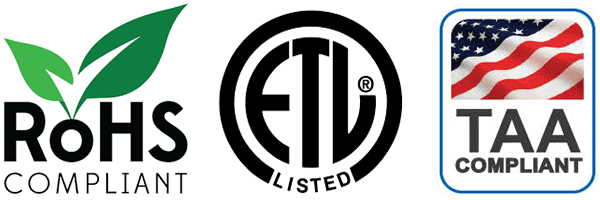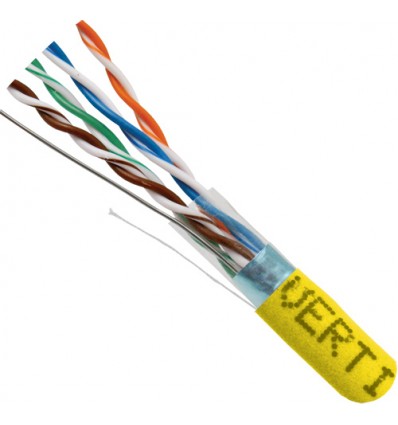CAT5E Shielded(F/UTP), Plenum Rated (CMP), 24AWG 8C Solid-Bare Copper,1000ft pull box, White, TAA Compliant, UL Listed
Features:
✅ High-Performance Data Communications Cable
✅ Suitable for 350MHz High-Speed Data Applications, Gigabit Ethernet, Fast Ethernet and 155Mbps TP-PMD/CDDI
✅ Designed for Indoor Installations
✅ Plenum Rated (CMP)
✅ Category-5E Shielded Twisted Pair (STP) Cable
✅ Easily Identified Color-Striped Pairs
✅ 24AWG Solid Bare Copper Conductors, 4-Pair
✅ Excellent Attenuation and Crosstalk Characteristics
✅ ANSI/TIA-568 C.2, ISO/IEC 2nd Edition 11801 Class D, CENELEC EN 50173-1
✅ Flame retardancy is verified to IEC 60332-1.
✅ UL Listed, RoHS, TAA Compliant
Description:
Cat5e plenum cable is designed for use in plenum spaces, which are areas in a building used for air circulation. This type of cable has a special insulation that is fire-resistant and low-smoke, which makes it suitable for installation in plenum spaces. The plenum cable is also designed to meet certain safety standards set by the National Fire Protection Association (NFPA) and other regulatory bodies.
Cat5e plenum cable is commonly used in commercial and industrial buildings, such as office buildings, schools, hospitals, and government buildings. It is often used to connect computers, printers, and other networking devices in a Local Area Network (LAN). This type of cable can also be used for other applications, such as CCTV security systems, VoIP phone systems, and audio/visual equipment.
When installing Cat5e plenum cable, it is important to follow the manufacturer's instructions and comply with local building codes and regulations. It is also important to use the appropriate tools and equipment, such as plenum-rated cable ties and connectors, to ensure proper installation and compliance with safety standards.
Plenum vs PVC Cable:
The main difference between Cat5e plenum cable and PVC cable is their insulation material. Cat5e plenum cable has a special insulation material that is fire-resistant and low-smoke, which makes it suitable for installation in plenum spaces, while PVC cable has a polyvinyl chloride (PVC) insulation material.
Plenum cable is required by building codes for use in plenum spaces because it is designed to prevent the spread of flames and smoke in the event of a fire. In contrast, PVC cable is not suitable for use in plenum spaces because it can release toxic fumes when it burns, which can pose a health hazard to building occupants.
Aside from the difference in insulation material, both Cat5e plenum cable and PVC cable can be used for similar applications, such as connecting computers, printers, and other networking devices in a Local Area Network (LAN). However, if you are installing cables in a plenum space, it is essential to use plenum-rated cables like Cat5e plenum cable to ensure compliance with local building codes and regulations and to ensure the safety of building occupants.
Copper Ethernet Cable vs CCA (Copper Clad Aluminum)
Cat5e copper cable and CCA (Copper Clad Aluminum) cable are two types of networking cables that are used for connecting computers, printers, and other devices in a Local Area Network (LAN). The main difference between them is the material used for the conductor, which is the central part of the cable that carries the electrical signal.
Cat5e copper cable has a solid conductor made of pure copper, while CCA cable has a conductor made of aluminum coated with a thin layer of copper. The use of CCA in place of copper in network cables is driven by the desire to reduce costs, as aluminum is less expensive than copper. However, this cost-saving measure can lead to a number of problems, including reduced performance and reliability.
Here are some of the key differences between Cat5e copper cable and CCA cable:
Conductivity: Copper is a better conductor of electricity than aluminum. CCA cable has a higher resistance than copper cable, which means that it can generate more heat and cause signal loss over long distances.
Flexibility: Copper cable is more flexible than CCA cable. This makes it easier to install and handle, especially in tight spaces or when making sharp turns.
Durability: Copper cable is more durable than CCA cable. It is less prone to breakage or damage due to repeated bending, stretching, or twisting.
Compatibility: Copper cable is compatible with all standard RJ-45 connectors and networking devices, while CCA cable may not be compatible with some devices due to its higher resistance.
Overall, Cat5e copper cable is the preferred choice for most networking applications, as it offers better performance, reliability, and compatibility than CCA cable.
Cables4sure has never and will never sell CCA cables!!!
Shielded vs Unshielded Cat5e Bulk Cable:
Shielded and unshielded Cat5e cables are two types of networking cables used to transmit data in Local Area Networks (LANs). The main difference between the two is the presence or absence of a shield or a grounding wire.
Unshielded Cat5e cable, also known as UTP (Unshielded Twisted Pair), is the most common type of Cat5e cable used in LANs. It consists of four twisted pairs of copper wires without any additional shielding. The wires are twisted together to reduce electromagnetic interference (EMI) from other devices or cables, and the signal is carried through the cable without any additional protection.
Shielded Cat5e cable, also known as STP (Shielded Twisted Pair), has a grounded foil or braided shield around the twisted pairs of wires. The shield provides additional protection against EMI and other types of interference, which can improve the signal quality and reduce the risk of data loss or corruption.
Here are some of the key differences between shielded and unshielded Cat5e cables:
Interference protection: Shielded Cat5e cables provide better protection against EMI and other types of interference than unshielded Cat5e cables.
Distance: Shielded Cat5e cables can transmit data over longer distances than unshielded Cat5e cables, due to their improved signal quality.
Cost: Shielded Cat5e cables are generally more expensive than unshielded Cat5e cables, due to the additional shielding materials and construction.
Installation: Shielded Cat5e cables can be more difficult to install than unshielded Cat5e cables, due to the additional shielding materials and grounding requirements.
Overall, shielded Cat5e cables are preferred for high-speed and critical applications that require the highest level of signal integrity and interference protection. Unshielded Cat5e cables are suitable for most other applications where interference is not a significant concern.



